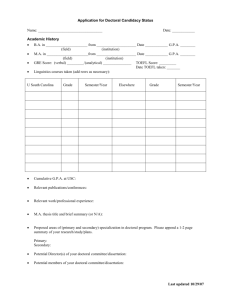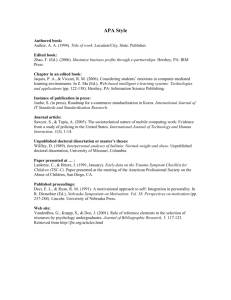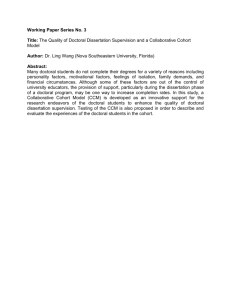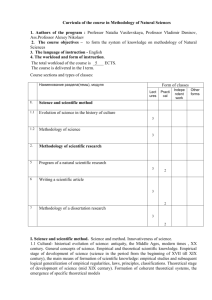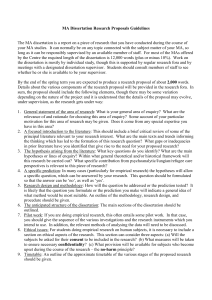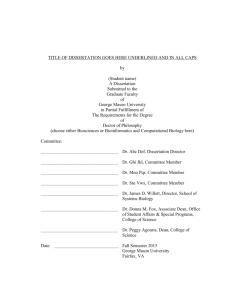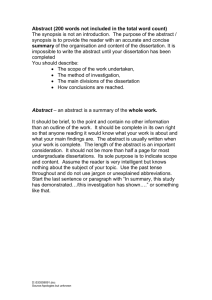Models of Dissertation Research in Design
advertisement
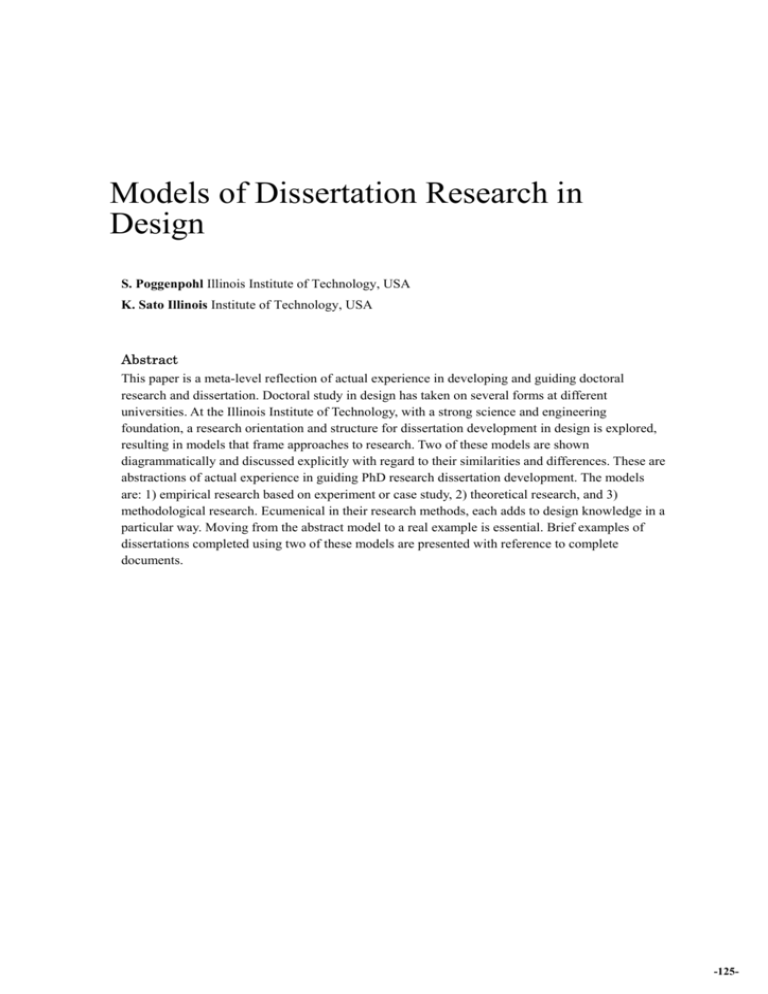
Models of Dissertation Research in Design S. Poggenpohl Illinois Institute of Technology, USA K. Sato Illinois Institute of Technology, USA Abstract This paper is a meta-level reflection of actual experience in developing and guiding doctoral research and dissertation. Doctoral study in design has taken on several forms at different universities. At the Illinois Institute of Technology, with a strong science and engineering foundation, a research orientation and structure for dissertation development in design is explored, resulting in models that frame approaches to research. Two of these models are shown diagrammatically and discussed explicitly with regard to their similarities and differences. These are abstractions of actual experience in guiding PhD research dissertation development. The models are: 1) empirical research based on experiment or case study, 2) theoretical research, and 3) methodological research. Ecumenical in their research methods, each adds to design knowledge in a particular way. Moving from the abstract model to a real example is essential. Brief examples of dissertations completed using two of these models are presented with reference to complete documents. -125- Papers Introduction Taking a practical but formal position built on a general theoretical research framework (Love, 2000), the Institute of Design at the Illinois Institute of Technology approaches PhD research through development of a research question (Poggenpohl, 2000, Meyer, 1995)) and examination of the question in terms of alternative approaches (Sato, 2000). This leads to appropriate research methods that yield evidence for the research findings. Evidence of a substantial pattern of results or a clear logic is essential if new knowledge is to receive serious consideration. Before examining research and dissertation models in use, a general description of the skills and knowledge to be acquired during the doctoral experience provides context (see table 1). Table 1. Skills and knowledge doctoral candidates can expect to develop Skills Institutional support • literature search • library research seminar including database search; faculty reading guidance • collaborative skill • research group participation; faculty co-investigation • writing • co-authored research papers; internal research records; submission to refereed journals; proposal and grant writing • presentation • internal doctoral seminars; submission to external conferences • teaching • co-teaching; research group leadership; focused course teaching • network building • faculty connections; conference presentations; active literature search and contribution • creative skill • formulation of research within constraints; development of experimental materials; prototypes • reasoning skill • construction and/or back-tracing of research experience Knowledge Institutional support • ability to construct and assess research • formal course in Philosophy of Design Research; informal seminars of • experience with several research methods • formal course in Methods of Design Research; research group; research • indepth knowledge in some area • faculty guidance research development; critical reading of existing research collaborations Models Doctoral work at the Institute of Design is based on an internal view of research needs in design; it seeks to develop knowledge that improves design performance in the world. Three models are in use: 1) an empirical model consisting of two variations, experimental work and case studies; 2) theoretical work; and 3) methodological work. All these models share a similar first phase with the subsequent two phases diverging according to research focus. The first phase is shown in Figure 1. -126- Figure 1. Phase 1 Establishing the research question The Ph.D. candidate joins a research group that is exploring a particular area of interest. Within the understanding of work and research in this interest area, the candidate seeks to pose a research question. The faculty considers the following: the student’s abilities and general preparedness to answer the question, whether the question is timely (able to be answered in a reasonable time) and whether it will have impact on the field of design and beyond. If the question is legitimate and answerable, the student engages in secondary research to determine if the question has been answered. If it has been answered, another question is created; if it is not answered, the question is fine-tuned based on methods and need for evidence. At this point, the research process is based on a specific research model. Two models are presented with brief discussion of an example dissertation: the experimental variation of the empirical model and the methodological model. Empirical/Experimental The empirical/experimental model seeks to create knowledge that not only serves the design profession but serves others as well. This model creates free, i.e., unbound knowledge, that, for example, adds to our understanding of human processing of information from a design perspective. This can be considered basic research. The model trades heavily on various forms of scientific research. To the degree it uses quantitative techniques as opposed to qualitative, it gets closer to science. The goal is to answer a very specific question through developing substantial evidence. Phases 2 and 3 of this model are presented in Figure 2. -127- Papers Figure 2. Phase 2 and 3 Pilot study and expansion of the empirical/experimental model Following a successful conclusion to phase 1, the research question is fine-tuned based on methodological possibilities and their ability to develop evidence through data collection and analysis. When the question and method are in place, a pilot study is launched to test drive the investigation. Problems regarding the design of the investigation, experimental materials, confusion on the part of subject/participants, analytical pitfalls and the reasonableness of the results can result in modification or redesign of the investigation. An appropriate outside adviser often consults on issues of method at this time. If the investigation can be resolved and results seem promising, a larger study (phase 3) is undertaken to more fully develop findings. The findings are analyzed from several perspectives, the results are synthesized, and the dissertation is written. Three possible papers result from this work at various points in its development. The first paper discusses existing research, its significance, controversies, and problems with regard to the research question under consideration. (It is often difficult to find a publisher for research summaries, however such papers provide a general platform for future development.) The second paper can result from the pilot study by focusing on the method issues and the promise of results. In this paper, the candidate is publicly establishing their research territory. The third paper is a product of the larger study and its analysis and synthesis of results. This is the paper we most often associate with writing research. Empirical/Experimental Example Chujit Jeamsinkul (2002) completed an investigation using this model. Her dissertation, “Methodology for Uncovering Motion Affordance in Interactive Media,” is an experimental study that investigates whether people assign similar meaning and emotional tone to basic motions on screen. Following an exploration of literature on motion from several disciplines (computer science, design, psychology, neuroscience) and two industrial perspectives (film and animation), she developed a research question. The question has three sub-questions: 1) what are the affordances of motion in interaction? 2) what attributes do people associate with them in terms of the effects (meaning) of each type of motion? And 3) do users have common understandings of motion? -128- Because the nature of the research was basic and because we understood the motion research under consideration to be potentially and over time, a very extensive investigation, quantitative methods with many subject/participants was an appropriate tool to both answer the question and develop a platform for subsequent research. An external advisor from clinical psychology suggested that the emotional affordance attached to particular motions might be an important feature of the meaning of motion. Fine-tuning the research strategy took considerable time following the pilot study (Jeamsinkul & Poggenpohl, 2001). (If one examines the time and effort related to constructing quantitative versus qualitative research, one discovers that considerable creativity and effort is required in the early stage of developing a quantitative experiment, but once constructed, the data collection and analytical tools provide for fairly quick and reliable results. In contrast, qualitative research is often less rigorous in its early design, with the research design evolving as experience develops. This means that some early research may need to be abandoned as the work finds its appropriate form. However, the analysis of qualitative work is time consuming and exacting. There is an inverse relationship between quantitative and qualitative work: quantitative work requires much effort at the beginning with data collection and analysis accelerating over time, while qualitative work starts more fitfully at the beginning, develops some speed and then slows down substantially during analysis.) The methods used in empirical research need to serve the question; one method is not automatically favored over the other. With one hundred subject/participants, the more extensive investigation yielded results that indicate that some motions have good agreement among people with regard to their meaning and emotional tone. These motions can correlate to interactive cues on screen (orienting, alerting, canceling, etc.). Further, the pattern of difference or similarity among the meaning and emotional force, can help designers to select a palette of appropriate and differentiated motions for use in interactive media (Jeamsinkul, 2002). Execution of the empirical/experimental model is well documented through the articles that mark various stages of research development and that are noted in the references. Methodological Model The goal of this class of research is to produce useful methods for practice or generalized methods that provides models for further development of domain specific methods. The scale of methods ranges from a method that supports a very specific activity in the design process to a method that supports the entire design process. Results of research are usually implemented as a tool to demonstrate its applicability and effectiveness for the intended roles in design. Some methods are focused on “design” practice and others are aimed at design-related activities common across different disciplines such as engineering and management. In order to propose a method for improving qualities of design activities, research needs to identify its target functions to be improved by a new method in the scope of an assumed design process model. Concerning the pattern of knowledge flow, this type of research is similar to the development of new fabrication technology based on scientific principles that enables new ways of designing products. It requires some theoretical foundation or scientific foundations to construct effective and replicable methods coherent with the assumed design process model. -129- Papers The first phase of this model shares the same process as the one for the experimental model (see figure 1). After research questions are formulated, knowledge of the state of the latest development is built through various forms of survey on practice and literature search revealing interconnections between different methods, theories and applications from the perspective of these questions. Through this information development, the PhD candidate needs to identify issues and problems in design practice, develop a map of historical development and different approaches of existing research efforts, relevant theories, and methods in any related areas regardless of disciplinary boundaries. The second phase generates a conceptual/methodological proposal as an alternative solution to the questions established earlier as shown in Figure 1. The key research activity in this phase is to introduce a well-structured program of the research and construct concepts of methods as a proposal. This involves identification of specific design functions and effective methods of improving or enabling their performance. The third phase most clearly characterizes this research model. The proposed methods or concepts are implemented as a working tool to support design practice. More publications are produced during this phase because the system implementation can be well and easily described in the form of technical reports. Figure 3. Phase 2 and 3 Concept development and implementation for the methodological model The problem most frequently pointed out for this research model is validation of the proposed methods. The effectiveness cannot be easily measured since it requires real use of the method in practice and the evaluation involves many variables. This problem is common to all methodological research across disciplines including engineering design. There are several mechanisms that can be used as pragmatic alternatives to standard scientific validation procedure with the cycle of hypothesis formation and logical or experimental proving. One is to set clear achievement goals and criteria prior to the development and evaluate the result against them. If the proposed method or concept is verified for enabling the specified function previously unavailable in the design process, the research result is considered to be validated. In order to enhance this validation, it is critical to develop a structured argument with a series of rationale or a commonly acceptable chain of logic for explaining how the original questions and final proposal are connected. Example of Methodological Model The latest example of this model is the dissertation “Design Information Framework for Integrating -130- Multiple Aspects of Design” by Youn-Kyung Lim completed in May 2003 (Lim, 2003). This research proposes a very generalized framework of design information as a information platform to accommodate multiple disciplinary viewpoints involved in interactive systems development and bridge different viewpoints and activities in the development process. It also provides a platform for method and tool development to support design activities, a mechanism to document and accumulate design knowledge, and a mechanism to back trace sequences of design rationale linking solutions, decisions and original problems. The first phase of research identified issues and existing methods in the field of practice and key methods currently in use. The discontinuity of information between different sectors and between different phases of the development is a commonly recognized problem causing incoherent development efforts and solutions. Then, existing methods currently in use in practice or related methods and approaches to solve the addressed problems, and related underlining theories were investigated. At the end of phase one, the PhD candidate had sufficient information in the area to position her research orientation in the overall scene and confirm the validity of her research question as a theme for her dissertation research. In the second phase, relevant theories such as General Design Theory and Structural Linguistics were used as a foundation for forming the basic concept of Design Information Framework while the general research method, strategy and program were formulated referring to other similar research contributions particularly in knowledge representation, modeling and design processes. The result of this phase for this project was a general concept of Design Information Framework that satisfies the requirements introduced at the beginning of the phase and the basic principles and an application case was published as a paper in a conference proceedings (Lim and Sato, 2001). The third phase was dedicated for implementation of the proposed framework and methods in order to demonstrate and validate the proposed framework with the initially stated criteria and the specifications of functional requirements for the methods implemented using the framework. The implemented methods and tools were then applied to small to medium scale example projects to evaluate their practical effectiveness. Through these application cases, the effectiveness of the proposed Design Information Framework and methods developed utilizing it was verified according to the validation standard of this type of research (Lim and Sato, 2003a, 2003b, and 2003c). The process included a few major recursive cycles of correcting the conceptual structure of the framework in Phase 2 according to some inconsistency or insufficiency problems recognized in the implementation in Phase 3. Conclusion Both models demonstrate the importance of formulating a precise research question and developing the evidence to substantiate any claim to knowledge or improvement of design process resulting from the research. Of the three models mentioned at the beginning of this article, the empirical/experimental variation model and the methodological model are the two most used at the Institute of Design. The empirical/case study model and the theoretical model are in a developmental stage at this time. -131- Papers References Jeamsinkul, Chujit. 2002. Methodology for Uncovering Motion Affordance in Interactive Media. PhD dissertation, Chicago: Illinois Institute of Technology. Jeamsinkul, Chujit and Poggenpohl, Sharon. 2001. “Motion Language for Interactive Media: Developing an Experiment to Uncover Common Meanings of Motion.” In The Proceedings of the 5th Asian Design International Symposium on Design Science. Seoul, Korea Jeamsinkul, Chujit and Poggenpohl, Sharon. 2002. “Methodology for Uncovering Motion Affordance in Interactive Media.” Visible Language, 36 (3): 254-280. Lim, Youn-Kyung. 2003. Design Information Framework for Integrating Multiple Aspects of Design. PhD dissertation, Chicago: Illinois Institute of Technology. Lim, Youn-Kyung and Sato, Keiichi. 2001. “Development of Design Information Framework for Interactive Systems Design.” In Proceedings of the 5th Asian International Symposium on Design Research. Seoul, Korea Lim, Youn-Kyung and Sato, Keiichi. 2003a. “Aspect Model-Based Methods for Scenarios and Prototype Development.” In Proceedings of the HCI International Conference 2003. Crete, Greece. Lim, Youn-Kyung and Sato, Keiichi. 2003b. “Encoding Design Scenarios with Design Information Framework for the generation of Multiple Aspect Models for System Implementation.” In Proceedings of the International Conference on Systems, Cybernetics, and Informatics. Orlando. Lim, Youn-Kyung and Sato, Keiichi. 2003c. Scenarios for Usability Evaluation: Using Design Information Framework and a Task Analysis Approach. In The Proceedings of the International Ergonomics Association 15th Technical Congress. Seoul, Korea. Love, Terrence. 2000. “A Meta-theoretical Basis for Design Theory.” In Doctoral Education in Design, Foundations for the Future, edited by D. Durling and K. Friedman. Staffordshire, UK: Staffordshire University Press. Love, Terrence. 2000. “Theoretical Perspectives, Design Research and the PhD Thesis.” In Doctoral Education in Design, Foundations for the Future, edited by D. Durling and K. Friedman. Staffordshire, UK: Staffordshire University Press. Meyer, Michel. 1995. Of Problematology, Philosophy, Science, and Language. Translated by David Jamison with Alan Hart. Chicago: University of Chicago Press. Poggenpohl, Sharon. 2000. “Constructing Knowledge of Design, part 2: Questions – An Approach to Design Research.” In Doctoral Education in Design, Foundations for the Future, edited by D. Durling and K. Friedman. Staffordshire, UK: Staffordshire University Press. Sato, Keiichi. 2000. “Constructing Knowledge of Design, part 1: Understanding Concepts in Design Research.” In Doctoral Education in Design, Foundations for the Future, edited by D. Durling and K. Friedman. Staffordshire, UK: Staffordshire University Press. -132-
